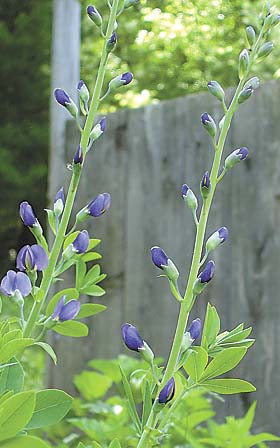By Paula Sirc
Home to more than 1,400 plants and animal species, 30 of which are designated rare species, the Shawangunk Ridge, with its exposed summits and deep-forested ravines, offers an amazing array of habitats for these plants and animals. The ridgeline is world-renowned for the biodiversity of its wildlife and plant communities, many of which are under threat by over-development and use of invasive non-native plantings in local gardens.
As we plot our summer gardens along the Shawangunk Ridge, it's important to remember the single most important rule in gardening: choosing the right selection of plants. Many concerned landscapers and property owners in the towns along the ridge are now trying to use native plant species in an effort to preserve the identity of the region.
Frances Groeters, who owns Catskill Native Nursery in Kerhonkson and holds a doctorate in zoology, defines native plants as those that "grow naturally in a certain region and were not introduced to that region by humans.
Groeters calls his concept, "gardening for a better environment"; and while it may not necessarily be a new notion, it's one he embraces wholeheartedly. He argues that, in terms of conservation, over-development has depleted our region of much of its wild land, and with it, much of its native plant populations. His nursery propagates native North American perennials, fruits, shrubs and trees in an effort to encourage gardeners to restore biodiversity by adding these plants to their landscapes.
| |

Baptisia australis blooming in late May. Photo by Sharon Richman
|
Native plants are also ornamental; as means of demonstration, Groeters has compiled a list of North American native plants that rival their Asian and European contemporaries in showy floral displays. Among the unusual plantings he cultivates in his nursery is
Baptisia australis, or Wild False Indigo, an herbaceous perennial that blooms in late-spring or early summer with magnificent spikes of pea-like periwinkle-blue flowers.
Another perennial that he champions for moist to average soils is the lobelia cardinalis, or Cardinal Flower, a great attraction for hummingbirds, with three foot stems that blossom a resplendent scarlet-red in mid-summer. New York Ironweed, or vernonia noveboracensis with its dark green foliage, blooms conspicuous purple flowers in late-summer.
An example of a shade tree that Groeters says is underused in local landscaping and yet manifests brilliant red fall foliage is the Nyssa sylvatica, also known as a Black Gum or Tupelo.
If a small shrub "with berries for critters and humans" is desired in local landscaping, Groeters recommends Gaylussacia baccata, or Black Huckleberry, which also presents delicate bell-like flowers in the springtime.
In addition, beautiful garden borders can be created using Joe-Pye-Weed (Eupatorium purpureum), Goatsbeard (Aruncus dioicus) or Black Cohosh (Actaea racemosa).
For Groeters, there are other very tangible reasons to use native plantings in local gardens. Quite simply, native plants are more likely to thrive during the region's warm, wet summers. Regionally indigenous plants provide habitat and food for wildlife better than non-native species because local wildlife is often adapted to local plant species. In addition, many popular exotic garden plants "escape" the confines of small residential or commercial gardens and invade wild lands and choke out native plants.
Plants that have been introduced into the region from other places are sometimes called invasive because they tend to spread rapidly. According to Mohonk Preserve, some examples of invasive plants found near the Shawangunks include Tree of Heaven, Garlic Mustard, Japanese Barberry and Purple Loosestrife. The best way to restore biodiversity on the ridge is to remove the invasive plantings and replace them with native plants.
With a plethora of amazing native flora to choose from, local gardeners need not sacrifice splendor and beauty to help restore the incredible diversity and unique qualities of the communities comprising the Shawangunk ridge. For a complete list of native, non-invasive plant alternatives, please visit Groeters' website at www.catskillnativenursery.com.
[ Rate Card ] [ Advertisers ] [ Contributors ] [ info@gunkguide.com ] [ home ]